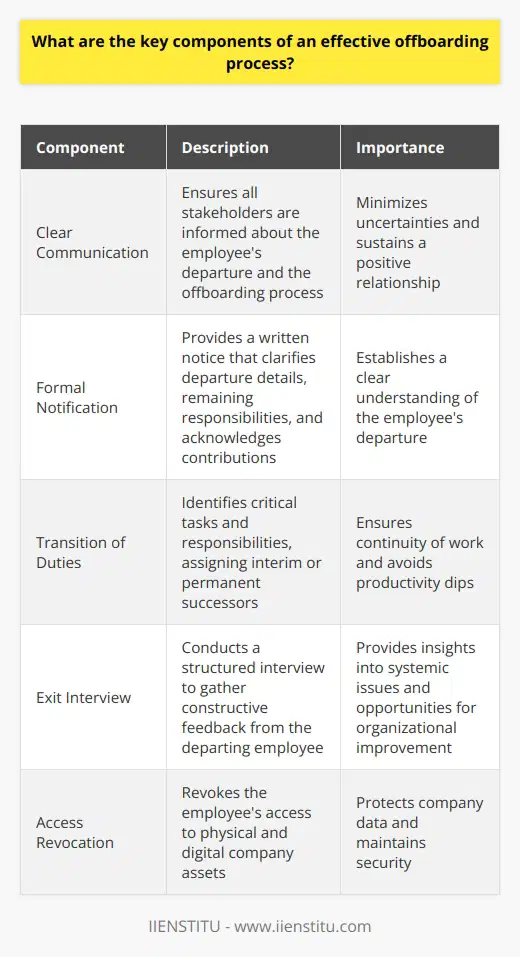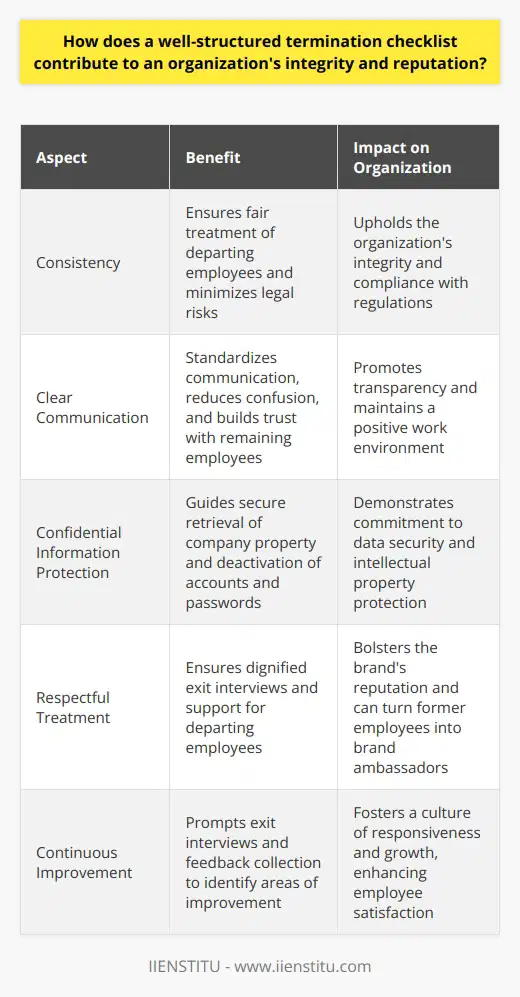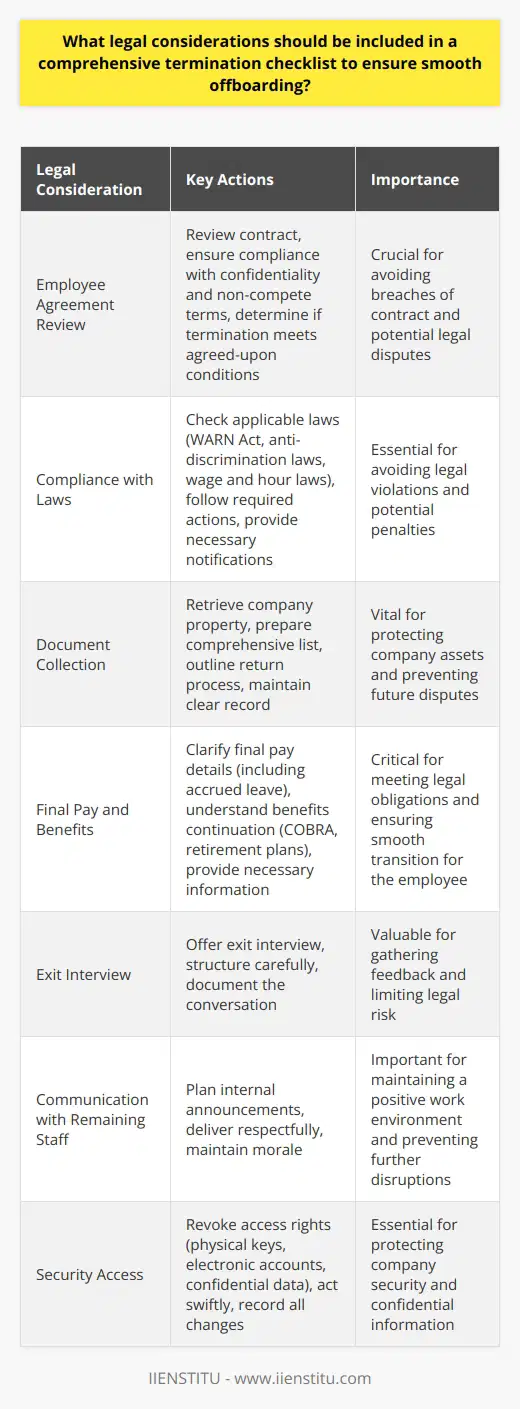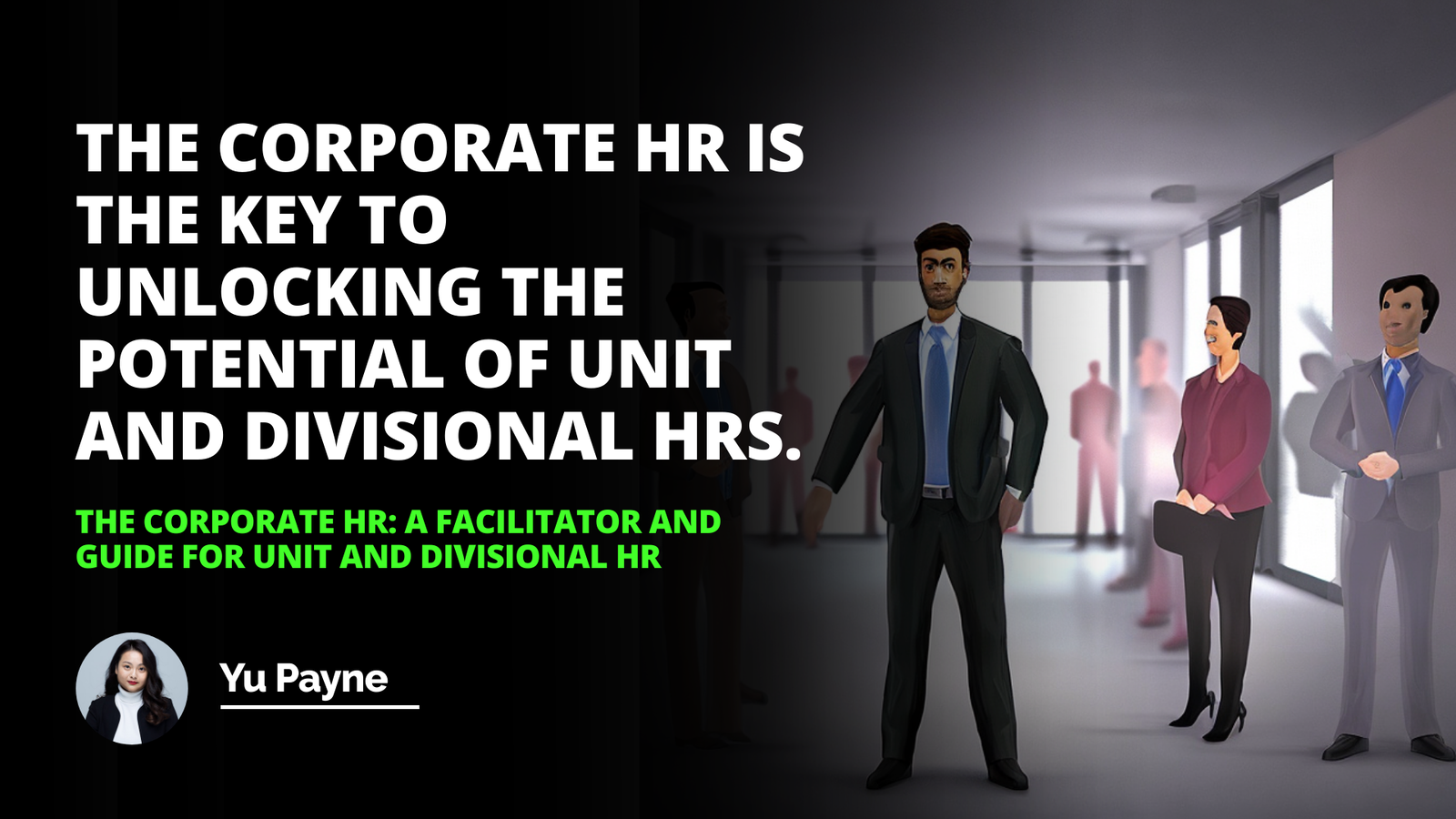
Terminating an employee is never an easy task. It's a process that requires careful planning, attention to detail, and a great deal of sensitivity. As someone who has been involved in numerous employee terminations over the years, I can attest to the fact that having a well-defined termination checklist template is essential for ensuring that the process is handled fairly, legally, and with respect for all parties involved.
I remember my first experience with employee termination. I was a young manager, and one of my team members had been consistently underperforming. Despite numerous coaching sessions and performance improvement plans, there was no significant change in their work. It became clear that termination was the only option.
At the time, I felt overwhelmed and unsure of how to proceed. Fortunately, my company had a comprehensive employee termination process guide that outlined the steps for terminating an employee. This guide was invaluable in helping me navigate the complex legal and emotional landscape of employee termination.
One of the key things I learned from this experience is the importance of documentation. Throughout the termination process, it's crucial to maintain detailed records of all communications, performance evaluations, and disciplinary actions. This documentation serves as a critical safeguard in the event of legal challenges or disputes.
As Nolo's Essential Guide to Federal Employment Laws emphasizes, "Documentation is your best defense against claims of discrimination or unfair treatment. Courts tend to believe documents generated at the time of an incident" (Guerin, 2020, p. 123). This advice has stuck with me throughout my career, and I make sure to prioritize meticulous record-keeping in all employee matters.
Another critical aspect of the termination process is treating the employee with dignity and respect. Losing a job can be a traumatic experience, and it's essential to handle the situation with empathy and professionalism. This includes providing the employee with a clear explanation of the reasons for their termination, as well as information about their final pay, benefits, and any support services available to them.
I once worked with a manager who failed to grasp the importance of this aspect of the termination process. They handled the termination in a cold, impersonal manner, leaving the employee feeling humiliated and resentful. The fallout from this mishandled termination was significant, with the employee filing a complaint with the Equal Employment Opportunity Commission (EEOC) and damaging the company's reputation in the process.
To avoid such situations, it's essential to follow the *best practices for employee offboarding. This includes conducting a thorough exit interview, providing the employee with a written termination letter, and ensuring that all legal requirements for employee termination* are met. Caruth and Caruth's research on effective exit interview strategies stresses the importance of using this as an opportunity to gather valuable feedback and insights (2013, p. 8).
One of the most challenging aspects of employee termination is handling sensitive information. Throughout the employment relationship, employees often have access to confidential company data, client information, and intellectual property. During the termination process, it's critical to ensure that this information is secured and that the employee's access is revoked promptly.
This is where a detailed termination checklist template can be incredibly useful. By outlining all the necessary steps, from disabling network access to collecting company property, a checklist ensures that nothing is overlooked in the chaos of the moment. Puckett's Employee Dismissal Law and Practice provides a comprehensive overview of the documentation needed for employee termination, including a sample termination checklist (2015, p. 231).
Of course, even with the best practices and procedures in place, mistakes during employee termination can still happen. One of the most common mistakes is failing to communicate the termination to other staff members in a timely and appropriate manner. This can lead to rumors, speculation, and a general sense of unease among the remaining employees.
To mitigate these risks, it's important to have a clear communication plan in place. This plan should outline who will be informed of the termination, when they will be informed, and what information will be shared. Bailey et al.'s Managing Human Resources offers valuable insights on navigating these sensitive communications (2018, p. 415).
In addition to the logistical and legal aspects of employee termination, there is also an emotional component that cannot be ignored. As a manager, it's important to approach the situation with empathy and an understanding of the impact that job loss can have on an individual's life. Dick's "The Psychology of Losing a Job" highlights the potential psychological repercussions of job loss and the importance of providing support and resources to help employees cope (2009, p. 87).
Ultimately, the goal of any employee termination should be to handle the situation with professionalism, compassion, and a commitment to following best practices. By developing a comprehensive termination checklist, staying current on legal requirements, and prioritizing clear communication and documentation, managers can navigate this challenging process in a way that minimizes risk and upholds the dignity of all involved.
References:
Bailey, J., Carstairs, G., Harbridge, R., & Townsend, K. (2018). Managing human resources (2nd ed.). Wiley.
Caruth, D. L., & Caruth, G. D. (2013). Effective exit interviewing: An underutilized, yet vital, tool. Journal of Business and Economics Research, 11(1), 7-12. https://doi.org/10.19030/jber.v11i1.7516
Dick, R. (2009). The psychology of losing a job. Journal of Occupational Science, 16(2), 87-91. https://doi.org/10.1080/14427591.2009.9686649
Guerin, L. (2020). The essential guide to federal employment laws (7th ed.). Nolo.
Puckett, J. R. (2015). Employee dismissal law and practice (6th ed.). Wolters Kluwer Law & Business.
Frequently Asked Questions
What are the key components of an effective offboarding process?
Introduction to Offboarding Components
Offboarding marks an employee's departure from an organization. It requires a systematic approach. An effective offboarding process ensures a smooth transition. It protects the company's interests and supports the departing employee.
Clear Communication
Communication is key. It guides the offboarding process. Make intentions clear. Address all stakeholders involved. This minimizes uncertainties. It sustains a positive relationship.
Formal Notification
Provide a formal notice. It clarifies departure details. This includes the final working day. It outlines remaining responsibilities. It also acknowledges the employee's contributions.
Transition of Duties
Plan duty handovers carefully. Identify critical tasks and responsibilities. Assign interim or permanent successors. Ensure knowledge transfer occurs. Avoid productivity dips.
Documentation
Document all vital information. Include project statuses and login credentials. Ensure successors understand the information. Record-keeping mitigates risk.
Exit Interview
Conduct an exit interview. It yields constructive feedback. Learn from departing employees. It can unveil systemic issues. This leads to organizational improvement.
Actionable Insights
Analyze exit interview data. Look for recurring themes. Develop strategies for retention. Rectify issues promptly.
Final Pay and Benefits
Calculate final pay accurately. Include accrued benefits. Ensure legal compliance. Give clear explanations. Dispute avoidance is crucial.
Recovering Assets
Retrieve company assets. Include hardware, software, and ID badges. Inventory checks prevent loss. Maintain asset control.
Access Revocation
Revoke access efficiently. Include physical and digital domains. Prevent unauthorized access. Protect company data. Security is non-negotiable.
Continual Improvement
Assess the offboarding process. Adapt and improve continuously. Stay abreast of best practices. Implement changes diligently. Strive for a flawless offboarding experience.
Conclusion
An effective offboarding process is multifaceted. It safeguards both the company and employees. It fosters a professional image. Aim for a respectful and thorough completion of employee tenure.

How does a well-structured termination checklist contribute to an organization's integrity and reputation?
Importance of a Structured Termination Checklist
Organizations strive for integrity and an untarnished reputation. A well-structured termination checklist ensures seamless transitions during employee departures. It reflects the company's commitment to professionalism and fairness. Moreover, it communicates respect for all parties and highlights transparency in processes.
Promotes Consistency
A standard checklist prevents inconsistencies. It ensures fair treatment of departing employees. All required steps become clear. This checklist minimizes legal risks and promotes compliance with regulations. These actions uphold the organization's integrity.
Supports Clear Communication
Departures often involve emotional and operational complexities. A checklist standardizes communication. It outlines when and how to inform the employee. Clear guidelines ensure employees understand the process. This reduces confusion and potential disputes. Transparent communication builds trust with remaining employees.
Protects Confidential Information
Intellectual property and data security hold paramount importance. A checklist guides the secure retrieval of company property. It covers return of access cards, devices, or documents. It also instructs on the deactivation of accounts and passwords. Through these steps, the organization demonstrates its commitment to data security.
Respects All Parties Involved
Professionalism during a termination is critical. A checklist ensures respectful interaction with the departing employee. It promotes dignified exit interviews and support. Respectful treatment bolsters the brand's reputation. It can even turn former employees into brand ambassadors.
Encourages Future Growth
Departures offer learning opportunities. Checklists prompt exit interviews and feedback collection. Organizations can identify areas of improvement. They can understand employee satisfaction and systemic issues. Responsiveness to feedback fosters a culture of continuous improvement.
Facilitates Compliance
Checklists align terminations with legal standards. They ensure adherence to contractual obligations. This minimizes the risk of wrongful dismissal claims. Regulatory compliance positions the organization as ethical and trustworthy.
Mitigates Risk
Structured termination by a checklist mitigates various risks. It addresses handover processes and system access revocation. Such details prevent operational disruptions. They maintain business continuity and client confidence.
Ensures a Smooth Succession
Planning for succession is part of a good termination process. Checklists ensure proper knowledge transfer. They help identify candidates for replacement. This planning shows stakeholders the company's proactive stance. It sustains trust and maintains a positive public image.
Conclusion
Organizations with structured termination checklists stand out. They show a clear commitment to equitable, respectful practices. These checklists are not mere procedural formalities. They embody the organization's dedication to its values. Ultimately, they preserve integrity and reinforce the company's positive reputation.

What legal considerations should be included in a comprehensive termination checklist to ensure smooth offboarding?
Legal Considerations in Termination Checklists
Employee Agreement Review
Start with the contract. Recall its clauses. Ensure compliance. These include confidentiality and non-compete terms. Does the termination meet agreed-upon conditions? Answer this decisively.
Compliance with Laws
Check applicable laws. They vary by jurisdiction. Key acts include:
- WARN Act
- Anti-discrimination laws
- Wage and hour laws
Do they apply? Determine this. Some demand specific actions. Follow these precisely. Include all necessary notifications.
Document Collection
Retrieve company property. Prepare a comprehensive list. Outline the return process. Make it foolproof. Documentation is pivotal. Maintain a clear record. This avoids disputes.
Final Pay and Benefits
Clarify final pay details. Does it include accrued leave? Understand benefits continuation. COBRA might apply. Are there company-sponsored retirement plans? Handle these with care. Provide necessary benefits information.
Exit Interview
Prepare for feedback. Offer an exit interview. Do this respectfully. Structure this carefully. It can limit legal risk. Document the conversation.
Communication with Remaining Staff
Plan internal announcements. Keep them straightforward. Deliver these respectfully. Maintain morale where possible.
Security Access
Revoke access rights. This includes:
- Physical keys
- Electronic accounts
- Confidential data
Act swiftly. Security is critical. Record all changes.
Reference and Unemployment Claims
Be ready for inquiries. Provide consistent responses. Anticipate unemployment claims. Respond to these lawfully. Remember the employee's rights. Navigate this delicate process thoughtfully.
In conclusion, apply due diligence. Respect all legal obligations. A comprehensive termination checklist ensures smoother offboarding. This eases the transition. It protects both parties. Prioritize such rigor.



